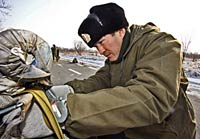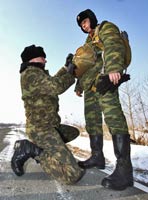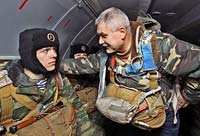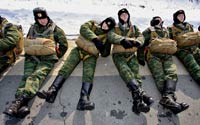| Tell a friend | Print version |
|---|
At the threshold of fear
Somebody will probably be more than surprised at the unusual ring to the combination marines and…the sky. But for the Black Berets of the Pacific Fleet, jumping from a plane with a parachute is just another routine exercise. Yes, marines are primarily meant to disembark from ships to mount assaults on coasts. In the Primorie region, the Klerka tip is used for such exercises. But what if in real combat these men are dropped from an airplane behind enemy lines?

Head of airborne-assault training at the marine division of the Pacific Fleet, Major Leonid Li
At the marine division of the Pacific fleet, such tasks are the domain of the marines’ assault battalion (MAB) under the command of Colonel Eugeny Kalashnikov. This is only natural, since the Black Berets, as an elite force, are part of the forces kept in constant combat readiness and should be able to do everything. It is no coincidence that in the process of reorganization of the assault division of the Pacific Fleet, Colonel Kalashnikov’s battalion will actually increase in size.
Given the fact that draftees will now only serve for just a year in the armed forces, it will become even more difficult to train the type of soldier a modern army needs. This is why at the MAB the training of new recruits is approached with the appropriate frame of mind: first a course for the new recruit, the taking of the oath, and only after a few weeks the first parachute jumps. Specialists believe what is important here is the psychological training of a new recruit in order to help him overcome fear since he is to jump from a helicopter at a height of 800 meters. The recruits are first carefully taught how a parachute works and how to properly fold it. The D-6 parachute has proven itself very worthy of trust since its inception in Soviet times.
“It is very simple to handle and easy to fold. That’s why sailors find no problem in mastering it,” said Major Leonid Li, the head of airborne-assault training for the navy assault division, with whom we made the trip that morning to the training grounds of the Marine Assault Battalion. True, the battalion would be grateful for new chutes; for example the new-generation D-10. But these remain available only to airborne forces. Even though the soldiers have begun receiving new equipment, the hope is that, as regards equipment for the Black Berets, there will be progress.
The division is also awaiting the new airborne-assault training simulator on which every element of chute-jumping can be simulated. In the meantime, the old simulator is still being used. What needs to be done in the sky is reflected on the simulator so that trainees can learn to repeat every step of a chute jump almost to perfection. Meanwhile, every trainee is required to remember that any mistake with the simulator can lead to an emergency during a drop from a plane.

Before boarding the plane
On this exercise, the new recruits, who are temporarily commanded by a graduate of the Kazan High Command College, Lieutenant Alexander Egorov, were to perform a demonstrative jump without weapons from a plane at an altitude of 800 meters. The trainees were transported to the airbase in two huge trucks. Everyone stayed silent during the entire trip, many replaying in their heads the jump they were about to perform from a very high altitude. Some at the very same time were already feeling the icy touch of fear on their skin. Some were smiling, thinking about how they were going to write to their girlfriends back home about this first jump experience.
Very few of these young men were prepared in their civilian lives to such extreme situations. For example, Sailor Boris Nikolaev, drafted into the pacific Fleet from Saratov, never thought about parachute-jumping. But Sergeyi Perevalov from Abakan had been practicing climbing for some years. He therefore feels more acutely the anticipation before the flight and fear of heights. He was very happy to have been drafted into the Battalion of navy marines, where he will be able to test his mettle.
The airmen had prepared to the coming event. An Antonov An-26 that took off from the Khabarovsk region was already near Primorie, and a group of pilots led by Major Sergey Omelyanovich was choosing which spot will be better as a drop zone.
“There is a light fog, but visibility is satisfactory,” Major Omelyanovich told his young colleagues from the military-transport escadrille.

Another check of the parachute
Omelyanovich was accompanied by aides to the commander of the An-26, Lieutenants Yuri Bukharov and Vladimir Korovnikov, both 2008 graduates of the Krasnodar Higher Military Aviation College, and the navigator, Lieut. Artem Artiushin, a recent graduate of a college in Chelyabinsk.
“We must lead the crew in a way that will make it hit the target precisely,” Sergei reflected with the officers. “I remember how last year, because of a slight miscalculation a sailor-paratrooper was carried into the forest by a strong wind and narrowly missed landing on a power line. This is what we’ll do: After the sailors have boarded the plane, it will make a loop of about 40 kilometers and drop one paratrooper to test the grounds. I will measure the point of touchdown, will give the azimuth, and the navigator, Senior Lieutenant Konstantin Chudinov, will add his height measurements. We will then determine precisely where to put the cross.”

Another instruction session
The important thing in the job of Major Oleg Omelyanovich and the crew of the An-26 under the command of Captain Yuri Fisenko is to achieve such precision as to allow all paratroopers to land within the designated zone.
In the meantime, the maximum amount of people allowed in the plane had boarded, including representatives of the search and rescue unit and airborne-assault forces of the military-transport escadrille, and it had taken off. Soon enough, the plane had gained altitude and distance.
It was unbelievable, but the faces of these young men, who were about to perform their second-ever jump form a parachute, showed absolutely no sign of fear. And when the youngsters shuffled to the back of the plane at the signal of Major Eugeny Borodin, none of them had the wide-opened eyes someone gripped by fear would have had. Apparently, the good training dispensed on-base had served its purpose.
“Ready! Go!”

A few seconds before the jump
The first to jump, in a trial jump, was performed by the instructor, Warrant Officer Eugeny Mironov. From our vantage point on the road on the apron of the dropping zone, we first noticed a black spot in the sky, and in a few seconds we saw the white cupola of a deployed parachute. The experienced paratrooper—for Warrant Officer Mironov this was the 552nd jump—calmly flew over the onlookers and landed beyond the road on the edge of the neighboring field.
“Ok. We’ll put the crosshair here, about 20 meters form the road,” Major Omelyanovich decided. Long red strips were immediately made on the frozen sandy-like earth. Nearby, between the field and the landing zone, camp fires were made to make it easier to find directions in the open field.
The An-26 had already performed a second loop.
“We can see you. Conditions are calm, you are authorized to begin work!” Major Omelyanov radioed the crew of the An-26.
First, second, third, fourth, fifth, sixth…
One after the other, in a perfect link, cupolas appeared in the sky. The link somehow inelegantly broke up, and two paratroopers, on the contrary, moved too close to one another.
“Move aside, look around!” shouted the head of the division, Major Leonid Li, who stood not far from a camp fire. “You should not just hang in the air; use the red strap to navigate! Turn and look at the drop zone, bring your legs together, prepare for landing!”

The moment of truth
The orders shouted from the ground apparently reached the paratroopers, as they begun navigating better toward the designated drop zone in the vicinity of the cross. Only one paratrooper, despite all efforts, was unable to take control of his chute. In a hard landing, he hurt his foot on the side of the road. The head doctor of the battalion, Senior Lieutenant Eugeny Zhidkov, after examining the hapless paratrooper, found no trauma. But the paratrooper nonetheless was deservedly scolded by his instructor, warrant officer Konstantin Khvadin. In training classes every recruit had been repeatedly warned that about 100 meters before touchdown, he should know exactly where and how he will land!
We walked to sailor Sergey Perevalov, who with a face full of happiness was folding his parachute. “The most challenging is waiting for the jump in the plane,” the young sailor-paratrooper confided. “After that, everything went according to what I was told in training: I counted aloud 551, 552, 553; pull the ring. I continued to count the seconds and looked to see whether the main parachute had deployed. Of course it had deployed! I hid the ring in my inside pocket in order not to drop it. And I was like a bird in the sky. It is simply unforgettable!”

The final word before the jump
“I began suffering from air sickness in the plane, so when the time came to jump, it was with great relief that I threw myself out of the plane,” said sailor Oleg Pechenin, a recruit from Khabarovsk, half-serious, half-joking. “I joined the division with a lot of determination. I want to become a real sailor-paratrooper,” Pechenin added.
“So many emotions at the conclusion of the jump!” exclaimed sailor Vasily Vasiliev form Perm. “In principle, it turned out just the way we were told in training. When the parachute deployed, I even spat to determine the direction of the wind, and I began piloting. I avoided two of my colleagues and normally landed on the field,” Vasiliev confided.
“I was barely able to wait in the plane. That’s how much I wanted to perform this jump!” said sailor Mohammed Gamidov from Dagestan. I know how to fight and can drive a Kamaz truck. But becoming a real paratrooper, I could only dream about it!”
“I made my first jump when I was a student at the military university,” said Alexander Vlasiuk, the deputy commander of the company in charge of discipline. “This time I had decided to repeat the experience; why, to teach your subordinates, you should first know the subject well!” he added.

Waiting for takeoff
The plane dropped a group of paratroopers after another over the designated zone. Last to jump and elegantly, dropping right on the cross, were the head of the search and rescue paratrooper-assault service of the escadrille, Alexander Kisilev (for him it was the 489th jump), Ivan Oleynik, a sailor from the same service, and Major Eugeny Borodin. For them, this was also a memorable event; another successful jump.
“The distribution in landing was rather satisfactory,” Major Sergey Omelyanovich assessed the session. “Not more than 40 meters from the cross. And the crew performed alright, and the paratroopers themselves held their ground,” he added.
The conclusion of the training session was drawn by Major Leonid Li in front of a formation of sailor-paratroopers. He described to the young recruits their mistakes in training and in the execution of the jump from the plane. He also congratulated them on another victory; a victory first and foremost on themselves. This is how yesterday’s schoolchildren are turning into real Black Berets and paratroopers able to master two environments: the sea and the sky!
Source: , Authors: Konstantin Lobkov, Vitaly Ankov (picture)
Translation: RusNavy.com



